+ Open data
Open data
- Basic information
Basic information
| Entry | Database: PDB / ID: 3jvb | ||||||
|---|---|---|---|---|---|---|---|
| Title | Crystal structure of infectious baculovirus polyhedra | ||||||
 Components Components | Polyhedrin | ||||||
 Keywords Keywords | VIRAL PROTEIN / Jelly-roll / disulfide bond / domain swapping | ||||||
| Function / homology | Polyhedrin / Polyhedrin / viral occlusion body / structural molecule activity / Polyhedrin Function and homology information Function and homology information | ||||||
| Biological species |  Wiseana signata NPV (virus) Wiseana signata NPV (virus) | ||||||
| Method |  X-RAY DIFFRACTION / X-RAY DIFFRACTION /  SYNCHROTRON / SYNCHROTRON /  MOLECULAR REPLACEMENT / Resolution: 2.17 Å MOLECULAR REPLACEMENT / Resolution: 2.17 Å | ||||||
 Authors Authors | Coulibaly, F. / Chiu, E. / Metcalf, P. | ||||||
 Citation Citation |  Journal: Proc.Natl.Acad.Sci.USA / Year: 2009 Journal: Proc.Natl.Acad.Sci.USA / Year: 2009Title: The atomic structure of baculovirus polyhedra reveals the independent emergence of infectious crystals in DNA and RNA viruses Authors: Coulibaly, F. / Chiu, E. / Gutmann, S. / Rajendran, C. / Haebel, P.W. / Ikeda, K. / Mori, H. / Ward, V.K. / Schulze-Briese, C. / Metcalf, P. | ||||||
| History |
|
- Structure visualization
Structure visualization
| Structure viewer | Molecule:  Molmil Molmil Jmol/JSmol Jmol/JSmol |
|---|
- Downloads & links
Downloads & links
- Download
Download
| PDBx/mmCIF format |  3jvb.cif.gz 3jvb.cif.gz | 56.9 KB | Display |  PDBx/mmCIF format PDBx/mmCIF format |
|---|---|---|---|---|
| PDB format |  pdb3jvb.ent.gz pdb3jvb.ent.gz | 40.6 KB | Display |  PDB format PDB format |
| PDBx/mmJSON format |  3jvb.json.gz 3jvb.json.gz | Tree view |  PDBx/mmJSON format PDBx/mmJSON format | |
| Others |  Other downloads Other downloads |
-Validation report
| Arichive directory |  https://data.pdbj.org/pub/pdb/validation_reports/jv/3jvb https://data.pdbj.org/pub/pdb/validation_reports/jv/3jvb ftp://data.pdbj.org/pub/pdb/validation_reports/jv/3jvb ftp://data.pdbj.org/pub/pdb/validation_reports/jv/3jvb | HTTPS FTP |
|---|
-Related structure data
| Related structure data |  3jw6SC S: Starting model for refinement C: citing same article ( |
|---|---|
| Similar structure data |
- Links
Links
- Assembly
Assembly
| Deposited unit | 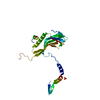
| |||||||||
|---|---|---|---|---|---|---|---|---|---|---|
| 1 | x 12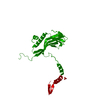
| |||||||||
| Unit cell |
| |||||||||
| Components on special symmetry positions |
| |||||||||
| Details | POLYHEDRA ARE VIRUS-CONTAINING CRYSTALS, WHICH REPRESENT THE MAIN INFECTIOUS FORM OF BACULOVIRUS. THE BIOLOGICAL ASSEMBLY IS THE WHOLE CRYSTAL. DODECAMERS OF THE POLYHEDRIN PROTEIN ARE PUTATIVE BUILDING BLOCKS OF THE CRYSTAL. INTERFACES INVOLVED IN GENERATING BIOMOLECULES 2-7 EXIST IN THE CRYSTAL BUT MAY NOT BE RELEVANT IN SOLUTION. |
- Components
Components
| #1: Protein | Mass: 28705.818 Da / Num. of mol.: 1 / Source method: isolated from a natural source Details: Crystals were directly purified from insects (larvae of porina moths) naturally infected by a baculovirus (Wiseana spp. nucleopolyhedrosis virus) Source: (natural)  Wiseana signata NPV (virus) / References: UniProt: O37157 Wiseana signata NPV (virus) / References: UniProt: O37157 |
|---|---|
| #2: Chemical | ChemComp-SO4 / |
| #3: Water | ChemComp-HOH / |
| Has protein modification | Y |
-Experimental details
-Experiment
| Experiment | Method:  X-RAY DIFFRACTION / Number of used crystals: 19 X-RAY DIFFRACTION / Number of used crystals: 19 |
|---|
- Sample preparation
Sample preparation
| Crystal | Density Matthews: 1.560221 Å3/Da / Density % sol: 21.164995 % |
|---|---|
| Crystal grow | Temperature: 300 K / pH: 7 Details: Natural intracellular Crystals were directly purified from larvae of porina moths infected by a baculovirus (WNPV), pH 7, temperature 300K |
-Data collection
| Diffraction | Mean temperature: 100 K |
|---|---|
| Diffraction source | Source:  SYNCHROTRON / Site: SYNCHROTRON / Site:  SLS SLS  / Beamline: X06SA / Wavelength: 1 Å / Beamline: X06SA / Wavelength: 1 Å |
| Detector | Type: MARMOSAIC 225 mm CCD / Detector: CCD / Date: Apr 5, 2009 / Details: MD2 DIFFRACTOMETER |
| Radiation | Monochromator: SAGITALLY HORIZONTAL FOCUSSING SI(111) MERIDIONALLY VERTICAL FOCUSSING RH-COATED MIRROR Protocol: SINGLE WAVELENGTH / Monochromatic (M) / Laue (L): M / Scattering type: x-ray |
| Radiation wavelength | Wavelength: 1 Å / Relative weight: 1 |
| Reflection | Resolution: 2.17→30 Å / Num. obs: 9646 / % possible obs: 99.9 % / Observed criterion σ(F): -3 / Observed criterion σ(I): -3 / Redundancy: 15 % / Biso Wilson estimate: 21.21 Å2 / Rmerge(I) obs: 0.349 / Net I/σ(I): 8 |
| Reflection shell | Resolution: 2.17→2.29 Å / Redundancy: 14.5 % / Mean I/σ(I) obs: 2.3 / % possible all: 100 |
- Processing
Processing
| Software |
| ||||||||||||||||||||
|---|---|---|---|---|---|---|---|---|---|---|---|---|---|---|---|---|---|---|---|---|---|
| Refinement | Method to determine structure:  MOLECULAR REPLACEMENT MOLECULAR REPLACEMENTStarting model: PDB ENTRY 3JW6 Resolution: 2.17→20.91 Å / Cor.coef. Fo:Fc: 0.945 / Cor.coef. Fo:Fc free: 0.932 / Occupancy max: 1 / Occupancy min: 0.33 / Isotropic thermal model: Isotropic / Cross valid method: THROUGHOUT / σ(F): 0 / Stereochemistry target values: Engh & Huber Details: Residue ACys131 forms a disulfide bond with residue BCys131 of symmetry molecule 4566. By symmetry, this also implies that residue BCys131 forms a disulfide bond with residue ACys131 of symmetry molecule 4566.
| ||||||||||||||||||||
| Displacement parameters | Biso max: 114 Å2 / Biso mean: 21.582 Å2 / Biso min: 5.7 Å2
| ||||||||||||||||||||
| Refine analyze | Luzzati coordinate error obs: 0.198 Å | ||||||||||||||||||||
| Refinement step | Cycle: LAST / Resolution: 2.17→20.91 Å
| ||||||||||||||||||||
| Refine LS restraints |
| ||||||||||||||||||||
| LS refinement shell | Resolution: 2.17→2.43 Å / Total num. of bins used: 5
|
 Movie
Movie Controller
Controller



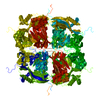

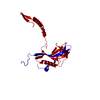
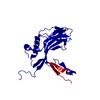

 PDBj
PDBj


